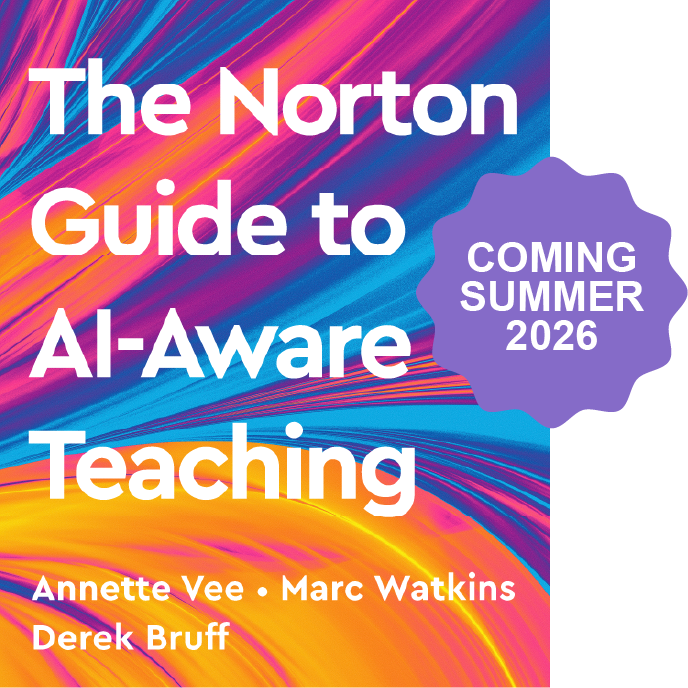

The Norton Guide to AI-Aware Teaching
The Norton Guide to AI-Aware Teaching will equip instructors with practical strategies for teaching effectively in the age of AI. AI-aware teaching means understanding how the technology impacts course goals, assignments, and students so that instructors can adapt with confidence. The guide provides steps for how to do so—whether the instructor is embracing AI, setting firm boundaries, or finding a balance. Flexible guidance and useful applications across disciplines empower instructors to adapt their learning outcomes to be AI aware.
Practical Organization: The guide will be organized chronologically as an instructor would approach preparing for or revising a course. This organization—which progresses from planning, designing, and teaching an AI-aware course to adapting instructional practices as AI evolves—will help teachers implement new, effective strategies immediately.
Flexible Guidance: Instructors can explore flexible, varied options for adapting their teaching to address AI’s impact on student habits and learning through frameworks that make AI-aware teaching both attainable and sustainable.
A Focus on Learning Outcomes: Instructors are motivated when they think in terms of their own students and their specific learning outcomes. The guide empowers instructors to make changes that make sense for their courses through compelling research, thorough examples, and practical strategies.
Useful Applications: Through inspiring examples, the guide will support the development of AI-aware assignments, activities, assessments, and course policies.
The Norton Guide to AI-Aware Teaching will publish in Summer 2026
To receive updates on the guide, please join our mailing list below.
Table of Contents
INTRODUCTION: What Is AI-Aware Teaching?
PART I: PLANNING AN AI-AWARE COURSE
1. Evaluating your course goals and learning outcomes
2. Meeting students where they are
3. What can AI do?
4. Online and hybrid courses
5. Choosing the role of AI in your course
6. Assessment approaches
7. Drafting AI policies and guidance
PART II: DESIGNING ASSIGNMENTS, ACTIVITIES, AND ASSESSMENTS
8. In-class activities
9. Out-of-class assignments
10. Reading
11. Writing
12. Research
13. Reflections
PART III: TEACHING YOUR COURSE
14. Authenticity, accountability, and transparency
15. Emphasizing student accountability
16. Using AI to enhance your teaching
17. Using AI as a tutor
CONCLUSION: WORKING TOGETHER
About the Authors

Annette Vee
Annette Vee, PhD, is Associate Professor of English at the University of Pittsburgh, where she teaches courses in writing, pedagogy, digital composition, AI, and literacy. Dr. Vee serves on various AI initiatives at the University of Pittsburgh, facilitated Pitt’s AI across the Disciplines program, and frequently gives keynotes and workshops on AI in higher education. She is the author of Coding Literacy: How Computer Programming Is Changing Writing, co-editor of TextGenEd: Teaching with Text Generation Technologies, and is working on a book that examines why and how humans have sought to automate writing across history. She writes for two Substacks: Computation & Writing and AI & How We Teach Writing.

Marc Watkins
Marc Watkins, MFA, directs the AI Institute for Teachers and is an Assistant Director of Academic Innovation at the University of Mississippi, where he is a Lecturer in Writing and Rhetoric. He has led research initiatives, exploring generative AI’s impact on student learning, training workshops for faculty on AI literacy, and several institution-wide AI institutes. His work with training faculty in AI literacy has been profiled in The Washington Post and he regularly writes about AI and education on his Substack, Rhetorica.

Derek Bruff
Derek Bruff, PhD, is an associate director at the University of Virginia's Center for Teaching Excellence, where supports faculty across the disciplines in integrating generative AI in their teaching. He is the author of Intentional Tech: Principles to Guide the Use of Educational Technology in College Teaching and Teaching with Classroom Response Systems: Creating Active Learning Environments. He produces the Intentional Teaching podcast and blogs about teaching with technology at Agile Learning. Bruff has taught mathematics courses at Vanderbilt and Harvard Universities.






